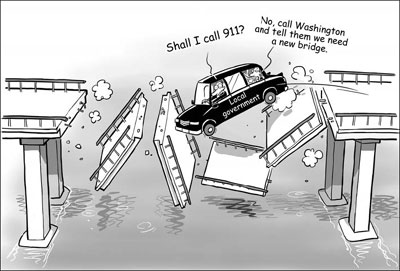Look after your bridges and they'll look after you
Updated: 2007-08-15 07:19
The horrific collapse of the Interstate 35W bridge in Minneapolis was but one more in the history of infrastructure failures, and I'm afraid it will be old news soon.
In 1967, during the busy Christmas shopping season, the Silver Bridge over the Ohio River between Point Pleasant, West Virginia, and Gallipolis, Ohio, collapsed, plunging scores of people into the river and killing 46.
During my nearly 20 years as an engineer with the New York City department of transportation, I witnessed numerous bridge failures, including the collapse of the West Side Highway in 1973, the fatal snap of a Brooklyn Bridge cable in 1981, and the 1989 fall of a concrete slab from the underdeck of Franklin D. Roosevelt Drive, which crushed a Brooklyn dentist in his car.
I was the engineer who closed the Williamsburg Bridge in 1988 after corrosion-induced cracks were discovered. Outside New York City there were two spectacular collapses: The Mianus River bridge in Connecticut, which killed three people in 1983, and the Schoharie Bridge in upstate New York, which killed 10 in 1987.

The typical federal and state response to a bridge collapse is to throw a bucket of money at the problem but then attach strings. Usually, the money can primarily be used on expensive capital improvements or new bridges but not for the "mop and pail" work the bridges really need.
It's like not doing basic maintenance on your car, letting the oil run out, waiting for the engine to seize up and then replacing the car. The cure of routine maintenance would have cost much less.
The United States spends a small fraction, proportionately, of what other countries spend on the basic maintenance of infrastructure.
States and localities do this because if they wait until bridges are in poor condition, they become eligible for federal funds. The budget offices in cities and states view federal money as other people's money. When it comes to infrastructure we have become junkies for other people's money.
We must become religious about basic maintenance. It appears that there were warnings of serious deficiencies on the I-35W bridge - signs of corrosion and more worrisome fatigue cracks. Not only must we increase the frequency of bridge inspections, but we need to use and develop technologies that predict problems.
The current inspections, which are required to take place every two years by the federal government, are largely visual and very subjective. Annual inspections must be required for bridges with fatigue cracks or serious corrosion.
Recent technology advances include electronic sensors that identify cracks and calculate the speed at which they are spreading.
Another instrument can look for changes in how much the bridge bends with a heavy load, and make electrochemical readings that measure corrosion activity - much like an electrocardiogram (ECG) looks for differences from past ECGs.
Bridges are machines with movable parts. They need to be cleaned regularly, especially to remove corrosive salt. Their parts, like rocker arms and bearing plates, must be lubricated. Their steel must be protectively coated with paint.
A 1989 study, which I commissioned for New York City's transportation department, concluded that the city's 840 bridges could be maintained in near pristine condition for $150 million annually. At the time, instead of conducting routine maintenance, we were spending $400 million a year to replace parts and even whole bridges.
Rather than lubricating the bearing plates that allow the Williamsburg Bridge to slide back and forth with changes in temperature and loads, we let the bearing plates jam, which cracked the concrete pedestal the span sat on.
Twice a year we needed to stop traffic, jack the bridge up and slide the pedestal back in place. Instead of coating the bridge's steel, we allowed it to become nearly paper thin. This required the replacement of beams, which made the repairs eligible for federal funds, instead of merely a paint job with city money.
Federal funds must be allowed for routine maintenance. But let's not rely only on Washington. Every state must set minimum maintenance standards and make it illegal for a jurisdiction not to meet them. A federal infrastructure inspector-general should have to certify each state's program with his or her professional engineer's stamp.
If our bridge maintenance programs are run correctly we will spend less money in the long run. Unfortunately, what's before us now is the bill of neglect for decades past.
The New York Times
(China Daily 08/15/2007 page11)
|
|
|
|
|
|